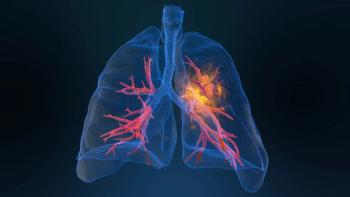
Oncology NEWS International
- Oncology NEWS International Vol 16 No 4
- Volume 16
- Issue 4
CT Lung Screens: No Lives Saved
Although CT screening increases the rates of lung cancer diagnosis and treatment among long-time smokers, data from three studies, individually and combined, show no evidence that such scanning reduces deaths from the disease
NEW YORKAlthough CT screening increases the rates of lung cancer diagnosis and treatment among long-time smokers, data from three studies, individually and combined, show no evidence that such scanning reduces deaths from the disease (JAMA 297:953-961, 2007). "Ours is the first study to ask whether detecting very small growths in the lung by CT is the same as intercepting cancers before they spread and become incurable," said first author Peter B. Bach, MD, of Memorial Sloan-Kettering Cancer Center. "We found an answer, and it was 'No.' Early detection and additional treatment did not save lives but did subject patients to invasive and possibly unnecessary treatments."
The authors noted that CT screening carries risks. If repeated yearly, the total radiation exposure becomes significant, and false-positive results may lead to further testing at higher radiation levels and lung biopsies. They called on physicians to await the outcome of two large, randomized, controlled trials of CT scans in high-risk individualsthe National Lung Screening Trial in the United States and the NELSON Trial in Europebefore rushing patients to CT screening.
The researchers analyzed data from 3,246 high-risk individuals who had enrolled in one of three single-arm studies that used state-of-the-art multi-detector CT machines to evaluate the technology's value as a screening tool for lung cancer. Each study provided participants an initial scan at entry and then an annual scan for at least 3 years thereafter.
The enrollees had a median age of 60.1 years and 1,917 (59%) were male. Their median years of smoking cigarettes was 39.1 years. None of the study members had a prior history of lung cancer or symptoms suggesting the disease.
The frequency of lung cancer observed in the three studies was compared to an estimate of risk derived from two validated models developed by Dr. Bach and senior author Colin B. Begg, PhD, chairman of epidemiology and biostatistics at Memorial Sloan-Kettering. One model estimated the risk of being diagnosed with lung cancer, and the other predicted the risk of dying of the disease.
At a median follow-up of 3.9 years, 144 participants were diagnosed with non-small-cell or small-cell lung cancers, compared with 44.5 diagnoses predicted by the model (P < .001). Of the 144 cancers, 42 were advanced vs 33.4 predicted by the model (not significant). Of the diagnosed patients, 109 had a resection, compared with the 10.9 surgeries predicted. Of the 144 diagnosed patients, 38 died, compared with 38.8 predicted by the model. "There was no evidence that CT screening reduced the risk of death due to lung cancer in any of the studies individually or combined," Dr. Bach and his colleagues wrote.
Articles in this issue
over 18 years ago
Curcumin Evaluated for the Treatment of Pancreatic Cancerover 18 years ago
Tykerb Approved for Metastatic HER2+ Breast Cancerover 18 years ago
Drug for BPH May Also Reduce the Risk of Prostate Cancerover 18 years ago
Phase III Trial of Prostvac-VF Is Launchedover 18 years ago
Electronic System Reminds Patients to Schedule Examsover 18 years ago
Phase II Trial of Panzem for Renal Cell Carcinoma Initiatedover 18 years ago
Chemotherapy May Enrich Tumorigenic Cells in Breast Caover 18 years ago
Watchful Waiting Management for Prostate Ca a Hard SellNewsletter
Stay up to date on recent advances in the multidisciplinary approach to cancer.















































































